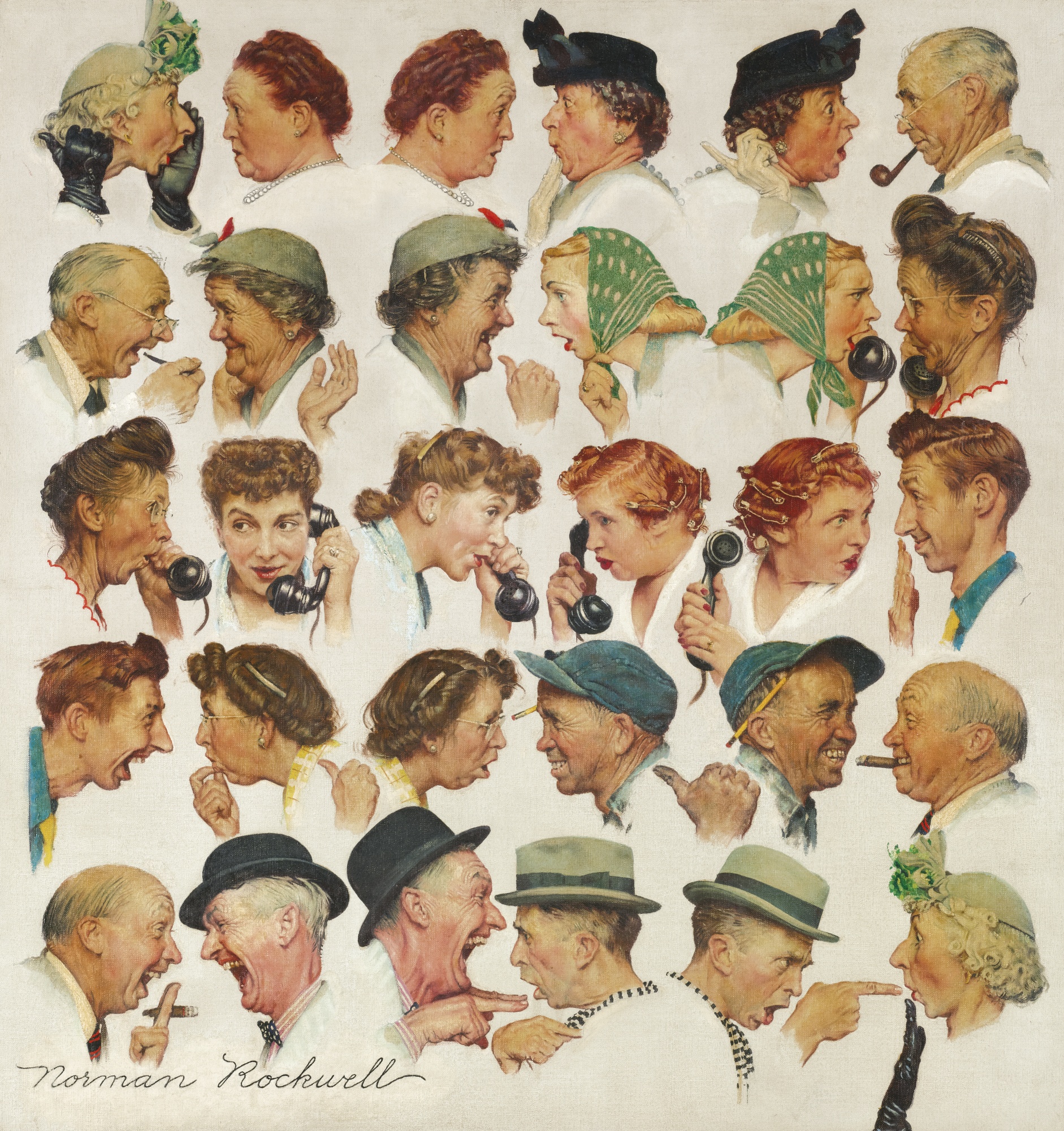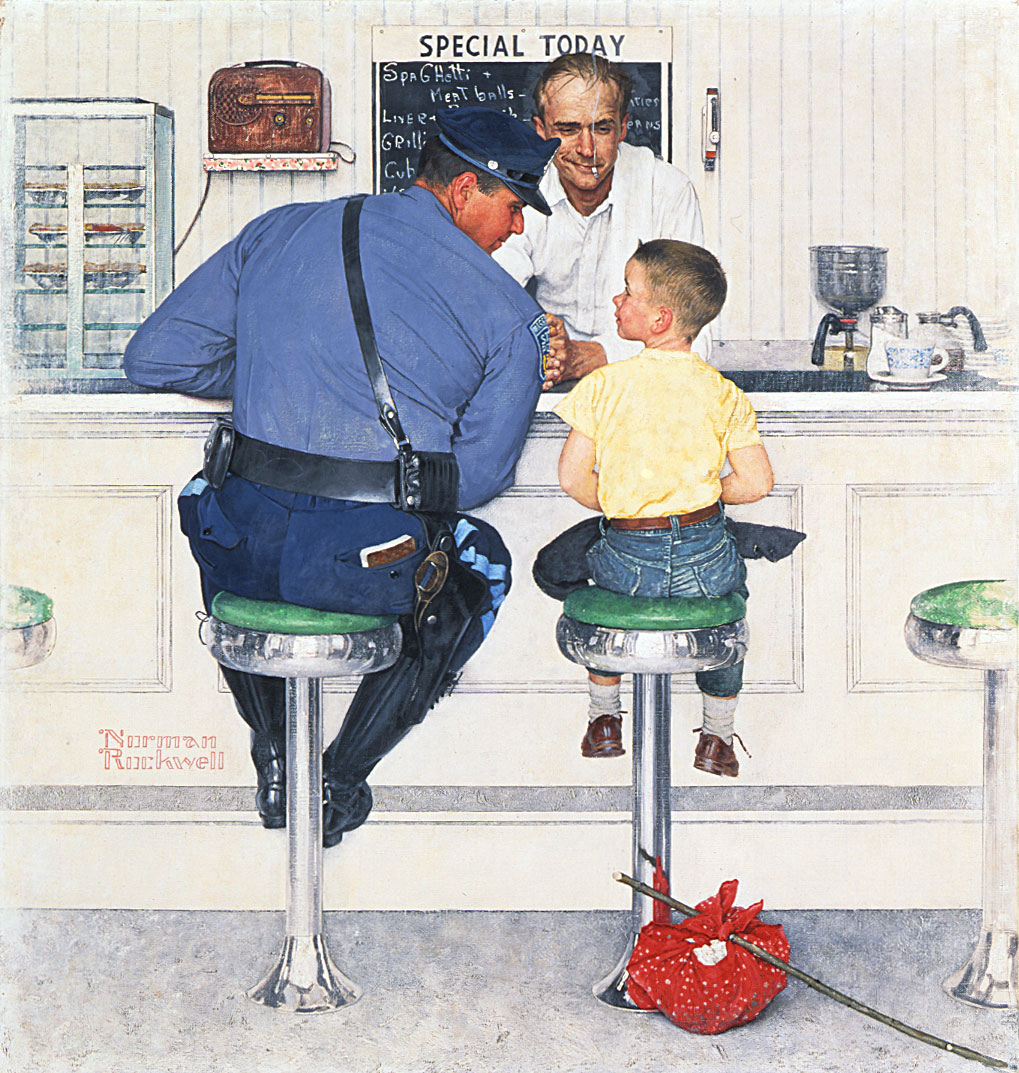Inspiration: Norman Rockwell and You
Overview:
This lesson will address Norman Rockwell’s points of inspiration including daily life in America and American culture. Students will work on a long-term illustration project including a schematic layout, draft and final illustration. Each student will consider Rockwell’s quote, “I was showing the America I knew and observed to others that might not have noticed.”
Eight 60 minute class periods: Class 1- Presentation; 2 &3 - Drafting; 4-7 Work to complete illustration; 7- Critique; 8-Adjustments, Hang and video shown.
Enduring Understandings/Essential Questions:
- Norman Rockwell was inspired by his own experiences and life around him. Generally, he was influenced by what he experienced on his vacations, nature, his neighbors and friends. He was inspired by the American culture in general, including holidays, and celebrations. Norman Rockwell was also inspired by specific groups, such as the Boy Scouts of America although he, himself, was not a member of the group.
- What inspired Norman Rockwell?
- What do you find inspirational?
- How might you be “inspired” to create an illustration representational of what you know and observe in your everyday life?
- How will you use color to emphasize a mood or atmosphere?
- Grade
- 9-12
- Theme
- Four Freedoms
- Length
- These activities may take eight 60 minute periods.
- Discipline
- Art
- Vocabulary
- Appropriation; Boy Scouts of America; Critique; Culture; Environment; Idioms; Inspire/Inspiration; Sketch; Representational Art; Symbol; Visual Narrative
Objectives:
- Students will view reproductions of Rockwell’s illustrations from various books.
- Students will consider everyday American life and cultural events as a means of inspiration (both for Rockwell and in preparation for their own piece of artwork).
- Students will look at The Runaway by Norman Rockwell and the work of Anthony Freda (adapted from Rockwell’s The Runaway ).
- Students will complete the worksheet Think Sheet: My America Sequence (9-12) so they may begin a schematic layout design for their own personal illustration about “My America.”
- Students will choose a piece of Rockwell’s art and modernize the work to be relevant to the current American culture.
Background:
Norman Rockwell was surrounded by a supportive (and inspirational) community of friends and fellow artists when he lived in Arlington, Vermont from 1939 to 1953. During this time he created The Gossips which became the most popular Saturday Evening Post cover in 33 years. Norman Rockwell used his neighbors as models, but did not want to insult them so he put himself and his wife into the cover design to avoid any suspicions his friends might have. The very first version began with just two gossips, then ten and finally developed into the multiple frames you see today.
Materials:
Multimedia Resources
The Gossips
The Runaway
American Chronicles: The Art of Norman Rockwell
Norman Rockwell Museum
Classroom Supplies:
- American Chronicles: The Art of Norman Rockwell by Linds Szekely Pero
- Worksheet: Think Sheet My America Sequence (9-12)
- Handouts: Copyright and the Digital Age
- Copies for each student of the article Rethinking Rockwell in the Time of Ferguson by
Max Kutner, August 26, 2014 (http://www.smithsonianmag.com/arts-culture/rethinking-rockwell-time-ferguson-180952485/) - Large easel with paper pad and pen
• Biography DVD: Norman Rockwell by A&E Television Networks, 2008 - Various media for students to decide on media more appropriate for their project
- Final draft paper, canvas, masonite or other materials as deemed appropriate for each project
Additional Teaching Resources:
The Norman Rockwell Museum at Stockbridge by The Norman Rockwell Museum
Norman Rockwell: Behind the Camera by Ron Schick
Norman Rockwell’s America by Christopher Finch
Norman Rockwell’s Four Freedoms: Images that Inspire a Nation by Stuart Murray, and James McCabe
Norman Rockwell’s Counting Book by Gloria Tabor
Norman Rockwell: Storyteller with a Brush by Beverly Sherman
My Adventures as an Illustrator by Norman Rockwell
A Rockwell Portrait: An Intimate Biography by Donald Walton
Activities:
Class 1
The students will be seated in a comfortable way so they are able to see one another and can participate in a class conversation led by the instructor. The teacher will have a marker/chalk/crayon and a board or easel to write on.
- Ask the students to listen attentively to one another as they share personal responses throughout the lesson. Ask a student to define the words inspire and inspiration. A definition will be written on the board to refer to later on in the lesson.
- An index card and a pencil will be given to each student. The students will be asked to respond to one or both of the following questions (on the index card), “What inspires you?” or “Who inspires you?” Students will be given three to five minutes to write down their ideas.
- Show an image of The Gossips by Norman Rockwell and ask the students if anyone has seen this illustration before. Ask the students to point out only what they see, not what they perceive; the class will collectively take a visual inventory. As each student contributes, restate their observation and write it on the board. You might be able to elaborate on what they have said to add more visual detail or you might ask them for clarification. You might encourage them to look more closely and carefully. By doing this, the students will analyze the work and find clues and symbols to help read the visual image, revealing American culture.
- Read an excerpt from American Chronicles: The Art of Norman Rockwell, by Linda Szekely Pero explaining the what inspired Norman Rockwell and how his family and surroundings helped grant him creative ideas for his artwork (page 99-100.) A group discussion will be prompted regarding Rockwell’s points of inspiration. The instructor will then ask the students to share with the class what they wrote down earlier about what inspires them. Student participation is critical to this discussion.
- Show a reproduction of the painting, The Runaway, and ask the students if anyone has seen this image before. Ask the students to point out only what they see, not what they perceive; the class will collectively take a visual inventory. As each student contributes, restate their observation and write it on the board. You might be able to elaborate on what they have said to add more visual detail or you might ask them for clarification. You might encourage them to look more closely and carefully. By doing this, the students will analyze the work and find clues and symbols to help read the visual image, revealing American culture.
Classes 2 -3
- Briefly review the list created last class about what inspired Norman Rockwell. Show piece of artwork Anthony Freda created based on Rockwell’s The Runaway. The article Rethinking Rockwell in the Time of Ferguson will be passed out to students to read together and a discussion about the two pieces, appropriation and copyrights will be prompted.
- Distribute the worksheet, Think Sheet My America Sequence 9-12 to all of the students. This will allow the students to brainstorm and plan their own illustration ideas. As students complete the worksheet, or struggle with their ideas, walk around and conference individually with each student until you feel they have a clear idea.
- Ask each student to choose what media they feel will best communicate their idea visually. Throughout the project, the students will be encouraged to talk with the instructor and their peers regarding their thoughts, ideas, and frustrations asking for help or feedback.
Classes 4-7
- Three more classes will be allotted to the completion of the student narratives. When most of the students have finished the project, ask the group to come together to conclude the project by presenting their illustrations to one another during a group critique to gain further feedback from their peers about their personal piece. Ask the students to present their project and explain their thoughts, particularly pointing out the one area where color has been intentionally used to emphasize a mood. Ask each student to point out what clues they have used so another may understand the setting and action. Once the artist has spoken, allow a couple of comments from classmates to be given. The comments must be given in a respectful manner, demonstrate critical thoughts and be relevant to the project. For example, a student might say, “I like the way you included a phone and texting as a way to show how we communicate now.”
Class 8
- Upon completion of the group critique, students will prepare an artist’s statement and prepare their project for display.
(Optional)
If time permits, allow for one final class period for any adjustments to be made on the final illustration or the artist’s statement. Play the biography DVD titled, Norman Rockwell by A&E Television Networks. All students, finished or still working will be enriched by watching and listening to the information presented in the DVD.
Assessment:
- Students will be evaluated on their participation in the class discussion and in the group critique (informal checks of understanding through questions.)
- Students will be evaluated on the completion of the worksheet, including thumbnail sketches for the final, individual project regarding their own interpretation of American life as they know it. Students will be expected to revise their work before completion of their final illustration.
- Students will be evaluated with a teacher designed rubric that evaluates student understanding of assignment.

